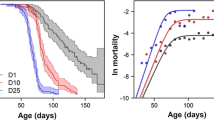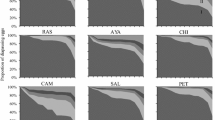Abstract
Laboratory and field investigations revealed that the life history traits of exephippial and parthenogenetic generations of Daphnia differ substantially. Daphniids hatching from resting eggs grow faster and their definitive body sizes are bigger than of hatchlings from subitaneous eggs. Size at maturity for exephippial animals is significantly larger. In spite of this, they mature a few days earlier than parthenogenetic females. In this study, the difference was 3–4 days for the laboratory experiments and 1–3 days for the field. Fecundity of the exephippial generation is markedly higher. Here, the clutch size for this generation was up to 3.5–4.0 times as large as for the parthenogenetic generation. Moreover, obtained results suggest that the relationship between clutch size and body length for both generations differ significantly.
Estimates of the intrinsic rate of increase for field Daphnia populations demonstrated that life history traits of exephippial animals lead to a two or threefold higher rate of increase in the conditions of invertebrate predation pressure. Under moderate fish pressure, obtained r values for the daphniids hatching from resting eggs were larger than those from subitaneous. High growth rate of exephippial females is disadvantageous only under the conditions of severe pressure by fish. Obtained results suggest that hatchlings from diapausing eggs an acceleration of population increase by several times during the beginning of the development of a population with periodical re-establishment from resting eggs.
Similar content being viewed by others
References
Alekseev, V. R., 1990. Diapauza rakoobraznykh: Ekologofiziologischeskiye aspekty [Diapuase in crustaceans: Ecologophysiological aspects]. Nauka, Moscow, 144 pp (in Russian).
Alimov, A. F., L. E. Anokhina, E. V. Balushkina, S. M. Golubkov, T. V. Khlebovich, P. I. Krylov, E. V. Paveljeva, I. V. Telesh & L. P. Umnova, 1992. Fish impact on the structure, abun dance, and biomass of plankton and benthos of two small shallow lakes: A three-year study. Russian Journal of Aquatic Ecology 1: 9–37.
Arbačiauskas, K., 1988. Dinamika rosta Daphnia longispina O. F. Müller v ozere Maly Okunyonok [The dynamics of growt h of Daphnia longispina O. F. Müller in Lake Maly Okunyonok]. In L. A. Kutikova (ed.), Ghidrobiologicheskie issledovaniya mo rskikh i presnyk vod. [Hydrobiological investigations of marine and fresh waters]. Zoological Institute, Leningard: 73–88 (in Russian).
Arbačiauskas, K., 1992. Dinamika populyatsiy i functsional'niye svyazi planktonnykh rakoobraznykh v ekosisteme ozer [Popul ation dynamics and functional relations of planktonic crustaceans in lake ecosystems]. Diss.... kand. biol. nauk [Ph. D. Thesis]. Zoological I nstitute, St.-Petersburg, 246pp (in Russian).
Argentesi, F., R. de Bernardi & G. Di Cola, 1974. Mathematical models for the analysis of populat ion dynamics in species with continuous recruitment. Mem. Ist. ital. Idrobiol. 31: 245–275.
Botrell, H. H., A. Dunca, Z. M. Gliwicz, E. Grygierek, A. Herzig, A. Hillbricht -Ilkowska, H. Kurasawa, P. Larsson & T. Welglenska, 1976. A review of some problems in zooplankton prod uction studies. Norw. J. Zool. 24: 419–456.
Brambilla, D. J., 1982. Seasonal variation of egg size and number in a Daphnia pulex population. Hydrobiologia 97: 233–248.
Carvalho, G. R. & R. N. Hughes, 1983. The effect of food availability, female-density and photoperiod on ephippia pro duction in Daphnia magna Straus (Crustacea, Cladocera). Freshwat. Biol. 13: 37–46.
Carvalho, G. R. & H. G. Wolf, 1989a. Resting eggs of lake-Daphnia. I. Distribution, abundance and hatching of egg s collected from various depths in lake sediments. Freshwat. Biol. 22: 459–470.
Carvalho, G. R. & H. G. Wolf, 1989b. Resting eggs of lake-Daphnia. II. In situ observations on the hatching of eg gs and their contribution to population and community structure. Freshwat. Biol. 22: 471–478.
De Stasio, B. T., Jr., 1990. The role of dormancy and emergence patterns in the dynamics of a freshwater zooplankton com munity. Limnol. Oceanogr. 35: 1079–1090.
Ebert, D., 1991. The effect of size at birth, maturation threshold and genetic differences on the life-history of Daphnia magna. Oecologia (Berlin) 86: 243–250.
Glazier, D. S., 1992. Effect of food, genotype, and maternal size and age on offspring investment in Daphnia magna. Ecology. 73: 910–926.
Green, J., 1954. Size and reproduction in Daphnia magna (Crustacea: Cladocera). Proc. zool. Soc. Lond. 124: 535–545.
Green, J., 1956. Growth, size and reproduction in Daphnia (Crustacea: Cladocera). Proc. zool. Soc. Lond. 126: 173–2 04.
Hebert, P. D. N., 1978. The population biology of Daphnia. Biol. Rev. 53: 387–426.
Hebert, P. D. N., 1987. Genetics of Daphnia. In R. H. Peters & R. De Bernardi (eds), Daphnia. Mem. Ist. ital. Idrobiol. 45: 439–460.
Herzig, A., 1985. Resting eggs—a significant stage in the life cycle of the crustaceans Leptodora kindti and Bythotrephes longimanus. Verh. int. Ver. Limnol. 22: 3088–3098.
Kankaala, P., 1983. Resting eggs, seasonal dynamics and productivity of Bosmina longispina maritima (P. E. Muller) (Cladocera) in the northern Baltic proper. J. Plankton Res. 5: 53–69.
Kleiven, O. T., P. Larsson & A. Hobaek, 1992. Sexual reproduction in Daphnia magna requires three sti muli. Oikos 65: 197–206.
Krylov, P. I. & K. Arbačiauskas, 1994. Are invertebrate predators capable to control populations of large herbivore s? Contribution of Chaoborus to the mortality of Daphnia in a small fishless lake. Russian J. aquat. Ecol. 3: 1–13.
Krylov, P. I., K. Arbačiauskas & B. L. Gutelmacher, 1993. Vliyanie ryb na dinamiku biomassy, chislen nosti i produktsii populyatsiy zhivotnykh: Populyatsii planktonnykh rakoorrazanykh i lichinok Chaoborus [Effects of fish on the dynamics of bio mass, abundance, and productivity of populations of animals: Populations of planktonic crustaceans and Chaoborus larvae]. In A. F. Alim ov (ed.), Bioticheskiye vzaimosvyazi v ekosistemkh ozer-pitomnikov [Biotic interactions in the ecosystems of nursery lakes]. Ghidrometeoi zdat, St.-Petersburg: 224–237 (in Russian).
Lampert, W., 1993. Phenotypic plasticity of the size at first reproduction in Daphnia: the importance of maternal size. Eco logy 74: 1455–1466.
Lei, C.-H. & H. F. Clifford, 1974. Field and laboratory studies of Daphnia schoedleri Sars from a wintekill lake of Alberta. Natl. Mus. Canada, Publ. Zool. 9: 1–53.
Lynch, M., 1989. The life history consequences of resource depression in Daphnia pulex. Ecology 70: 246–256.
Makrushin, A. V., 1985. Anghidrobioz pervichnovdnykh zhivotnykh [Anhdrobiois in primary aquatic animals]. Nauka, Lening rad, 104 pp (in Russian).
McCauley, E., W. W. Murdoch & R. M. Nisbet, 1990. Growth, reproduction and mortality of Daphnia pulex Leydig: life at low food. Functional Ecology 4: 505–514.
Moritz, C., 1987. A note on the hatching and viability of Ceriodaphnia ephippia collected from lake sediments. Hydrobiologi a 145 (Dev. Hydrobiol. 35): 309–319.
Orcutt, J. D., Jr., & K. G. Porter, 1984. The synergistic effects of temperature and food concentration on life h istory parameters of Daphnia. Oecologia 63: 300–306.
Paloheimo, J. E. & W. D. Taylor, 1987. Comments on life-table parameters with reference to Daphnia pulex. The oretical Population Biology 32: 289–302.
Schwartz, S. S. & P. D. N. Hebert, 1987. Methods for the activationof the resting of Daphnia. Freshwat. Biol. 17: 373–379.
Stibor, H., 1992. Predator induced life-history shifts in a freshwater cladoceran. Oecologia (Berlin) 92: 162–165.
Stross, R. G., 1966. Light and temperature requirement for diapause development and release in Daphnia. Ecology 47: 368–374.
Stross, R. G., 1969a. Photoperiod control of diapause in Daphnia. II. Induction of winter diapause in the arctic. Biol. Bul l. 136: 264–273.
Stross, R. G., 1969b. Photoperiod control of diapause in Daphnia. III. Two-stimulus control of long-day, short-day induction. Biol. Bull. 137: 359–374.
Stross, R. G., 1971. Photoperiod control of diapause in Daphnia. IV. Light and CO2-sensitive phaseu within the cycle of activation. Biol. Bull. 140: 137–155.
Stross, R. G., 1987. Photoperiodism and phased growth in Daphnia populations: coactions and perspective. In R. H. Peters & R. De Bernardi (eds), Daphnia. Mem. Ist. ital. Idrobiol. 45: 413–437.
Stross, R. G. & J. C. Hill, 1965. Diapause induction in Daphnia requires two stimuli. Science 150: 14 62–1464.
Stross, R. G. & J. C. Hill, 1968. Photoperiod control of winter diapuase in freshwater crustacean Daphnia. Biol. Bull. 134: 176–198.
Tessier, A. J. & N. Consolatti, 1989. Variation in offspring size in Daphnia and consequences for individual fitne ss. Oikos 56: 269–276.
Vanni, J. M., 1987. Effects of food availability and fish predation on a zooplankton community. Ecol. Monogr. 57: 61–88.
Weider, L. J. & J. Pijanowska, 1993. Plasticity of Daphnia life histories in reponse to chemical cues from predat ors. Oikos 67: 385–392.
Zaffagnini, F., 1987. Reproduction in Daphnia. In R. H. Peters & R. De Bernardi (eds), Daphnia. Mem. Ist. ital. Idrobiol. 45: 245–284.
Author information
Authors and Affiliations
Rights and permissions
About this article
Cite this article
Arbačiauskas, K., Gasiūnaitė, Z.R. Growth and fecundity of Daphnia after diapause and their impact on the development of a population. Hydrobiologia 320, 209–222 (1996). https://doi.org/10.1007/BF00016822
Issue Date:
DOI: https://doi.org/10.1007/BF00016822




